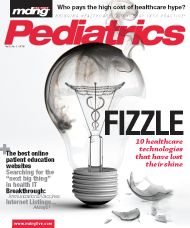Publication
Article
The Next Big Thing: Advances in pediatric health information technology
We must overcome all of the technical, political, and economical obstacles NOW. The need for system efficiency and patient safety demands it.
Health information technology applications (electronic health records, e-prescribing, computerized order entry, and clinical
decision support) have been around for years. Their use has been advocated to improve the safety, efficiency, and effectiveness of care, yet their widespread adoption, especially among smaller practices, is still elusive. Despite incentives (such as pay for performance) for compliance and legislated penalties for non-compliance (as for e-prescribing), US uptake is still slow (14—20% by recent estimates). The principal barrier may be lack of a perceived return on investment.
While there are tangible benefits to patients, payors, and regulators, the cost of purchasing, implementing, and maintaining systems falls largely on physicians. One trend is to remove barriers to health IT adoption through subsidizing costs of purchase and implementation of EHRs, as recently advocated by Health IT Now!, a national coalition of healthcare, vendor and advocacy groups. Concurrent with this trend is legislative interest in mandating the use of health IT to increase reporting of performance data. The American Academy of Pediatrics (AAP) Department of Federal Affairs is monitoring and
influencing upcoming legislation regarding health IT that may affect pediatricians.
To that end, studies that demonstrate definitive cost savings, enhanced workfl ow, or improved quality and safety are needed. A second trend is to empower patients and families to manage their health information. The increasing availability of PHRs through employers, EHR vendors, and independent providers such as Microsoft (Health Vault) and Google (GoogleHealth) have put PHRs in the public eye. The concept of a central electronic repository for personal health information is compelling
and appealing to patients, physicians, and employers for different reasons. For patients (especially those with complex medical histories such as children with special healthcare needs), it is simplifi cation of keeping records (that are otherwise easily lost). For physicians, it helps provide medical histories in emergent situations.
The AAP and the American College of Emergency Physicians (ACEP) have collaborated on the format for a record that serves this purpose. An associated application, the patient portal, is an online tool that is linked to a practice EHR and that allows patients and families secure access to their personal health information, including vaccine history, medications, laboratory results, imaging, and even exam scheduling, plus communication summaries fi ltered through password-protected e-mail. Physicians and/or patients may limit availability of specifi c data items to the portal interface. The distinction between a PHR and a patient portal is that patients submit and control content in a PHR; practitioners and staff enter the clinical information into the EHR that forms the basis for a portal.
A third trend is the increasing use of mobile computing and communications in healthcare and health. Smart phones—a combination of cell phone, handheld computing, and Web technologies—will see more use in pediatrics and can improve workfl ow. Newer versions, with larger color touchscreens, may prove successful where other forms of health IT have failed. Th eir ubiquity, relative lower cost, higher computing power, and Web access mean they are increasingly capable of running various medical applications (including access to current online health information sources) for patient care; education and research make them useful during the patient encounter, on rounds, and from home and hospitals. However, an important safety issue associated with the use of this technology in adult and teen populations is to limit their use while driving. A fourth trend is an increasing focus on patient privacy and security of protected health information. As the use and availability of electronic health information increases, particularly in online PHRs, the need to protect data from breaches and misuse (such as health identity theft), as well as ensure transparency of recovery procedures, will increase as the probability of these events increases. Th ese trends and predictions are dynamic. As progress in information technology and informatics in healthcare continues, the AAP Council on Clinical Information Technology (COCIT) continues to monitor developments in legislation, industry, and informatics research that may have signifi cant eff ects on pediatric care.
Dr. Kim is a member of the executive committee and abstract chair for COCIT. Dr. Simonian is chair of COCIT.
